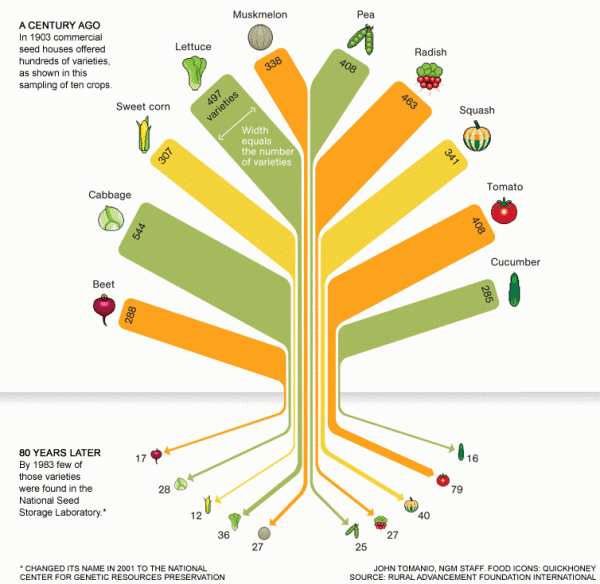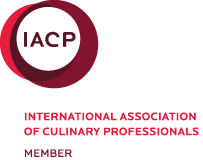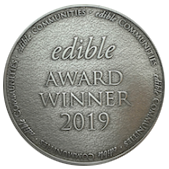A friend and colleague, David C. Baker, sent me a link to an article from National Geographic that explains how food sources—crops, vegetables and animals bred for food—around the globe are becoming less biologically diverse. The story, titled Food Ark, is very interesting and worth reading if you, you know, eat.
Writer Charles Siebert explains that we’re quickly reversing the work that humankind has done over 10,000 years: building a broad range of food sources that are bred to thrive in localized conditions and feed a community. Here’s a snapshot of the issues we’re facing:
Most of us in the well-fed world give little thought to where our food comes from or how it’s grown. We steer our shopping carts down supermarket aisles without realizing that the apparent bounty is a shiny stage set held up by increasingly shaky scaffolding. We’ve been hearing for some time about the loss of flora and fauna in our rain forests. Very little, by contrast, is being said or done about the parallel erosion in the genetic diversity of the foods we eat.
Food varieties extinction is happening all over the world—and it’s happening fast. In the United States an estimated 90 percent of our historic fruit and vegetable varieties have vanished. Of the 7,000 apple varieties that were grown in the 1800s, fewer than a hundred remain. In the Philippines thousands of varieties of rice once thrived; now only up to a hundred are grown there. In China 90 percent of the wheat varieties cultivated just a century ago have disappeared. Experts estimate that we have lost more than half of the world’s food varieties over the past century. As for the 8,000 known livestock breeds, 1,600 are endangered or already extinct.
Why does this matter? Put simply, the less diverse our food source, the more susceptible it is to new disease and pests. Think of the human corollary to this theory: As we’ve increased our usage of antibiotics, the bugs themselves have rapidly adapted, and new strains, like MRSA, have emerged that are drug-resistent. While penicillin and its kin are life-saving drugs, to be sure, our over-reliance on them to treat modest infections (think: a mild case of sinusitis) has triggered more resistent bugs. It’s the Law of Unintended Consequences.
Siebert cites a parallel in wheat cultivation. Wheat has always been susceptible to a kind of fungus that destroys the plant. We’ve developed strains that are resistent to the fungus, but the fungus has adapted more quickly. There’s now an epidemic of the fungus in Africa, and it’s spreading quickly. Ninety percent of the world’s wheat crop is not resistent. An outbreak in Asia and the U.S. could wipe out most of this staple of our food supply.
On the face of it, the genetic engineering that agribusiness giants pursue seems like a good cause. Crops are bred for maximum yields, so they feed many mouths. But there’s a cost, as Siebert explains:
Monocropping vast fields with the same genetically uniform seeds helps boost yield and meet immediate hunger needs. Yet high-yield varieties are also genetically weaker crops that require expensive chemical fertilizers and toxic pesticides. The same holds true for high-yield livestock breeds, which often require expensive feed and medicinal care to survive in foreign climates. The drive to increase production is pushing out local varieties, diluting livestock’s genetic diversity in the process. As a result, the world’s food supply has become largely dependent on a shrinking list of breeds designed for maximum yield: the Rhode Island Red chicken, the Large White pig, the Holstein cow.
He goes on to note that Ireland’s reliance on a single genetic strain of a single crop—the Lumper potato—led directly to the devastating famine in the mid-1800s.
I could quote Siebert’s article all day long, but that’s not good journalism. Instead, I’ll just point you to his very well-written text (Food Ark, National Geographic, July 2011), which also digs into efforts that small farmers around the globe are taking to preserve ancient crops by saving their seed (he also writes of the Seed Savers Exchange in Iowa).
The heirloom tomatoes sold for five bucks a pound in the farmers’ market may seem trendy for the table. But they may hold the key to our food security.
What do you think? Let’s have a conversation in the Comments section below.
Image source: Food Ark, National Geographic






Thanks for sharing this article. I find the rapid decline in the genetic diversity of our food supply alarming (the graphic above really brings home the point solidly). My husband Bill and I raise a rare breed of pig, Red Wattle hogs, on our farm, and we occasionally run into folks who wonder how we can bring ourselves to eat an endangered species. We explain that, since their purpose is to provide food, in order to save them, one must eat them. Otherwise, we and other farmers would not be able to afford to raise them, and they quickly would go extinct, their unique genetic make-up lost forever. One more reason to try to eat fresh, locally-grown food as often as possible.
Beth, I absolutely thought of Dean Family Farm when I read this article, especially since it cites the Large White pig as a prime example of the problem with lack of diversity. I really admire what you and Bill are doing — it is SO important!!
Pingback: The cost of junk food vs. whole food. | writes4food | cooking, eating, drinking in the Midwest